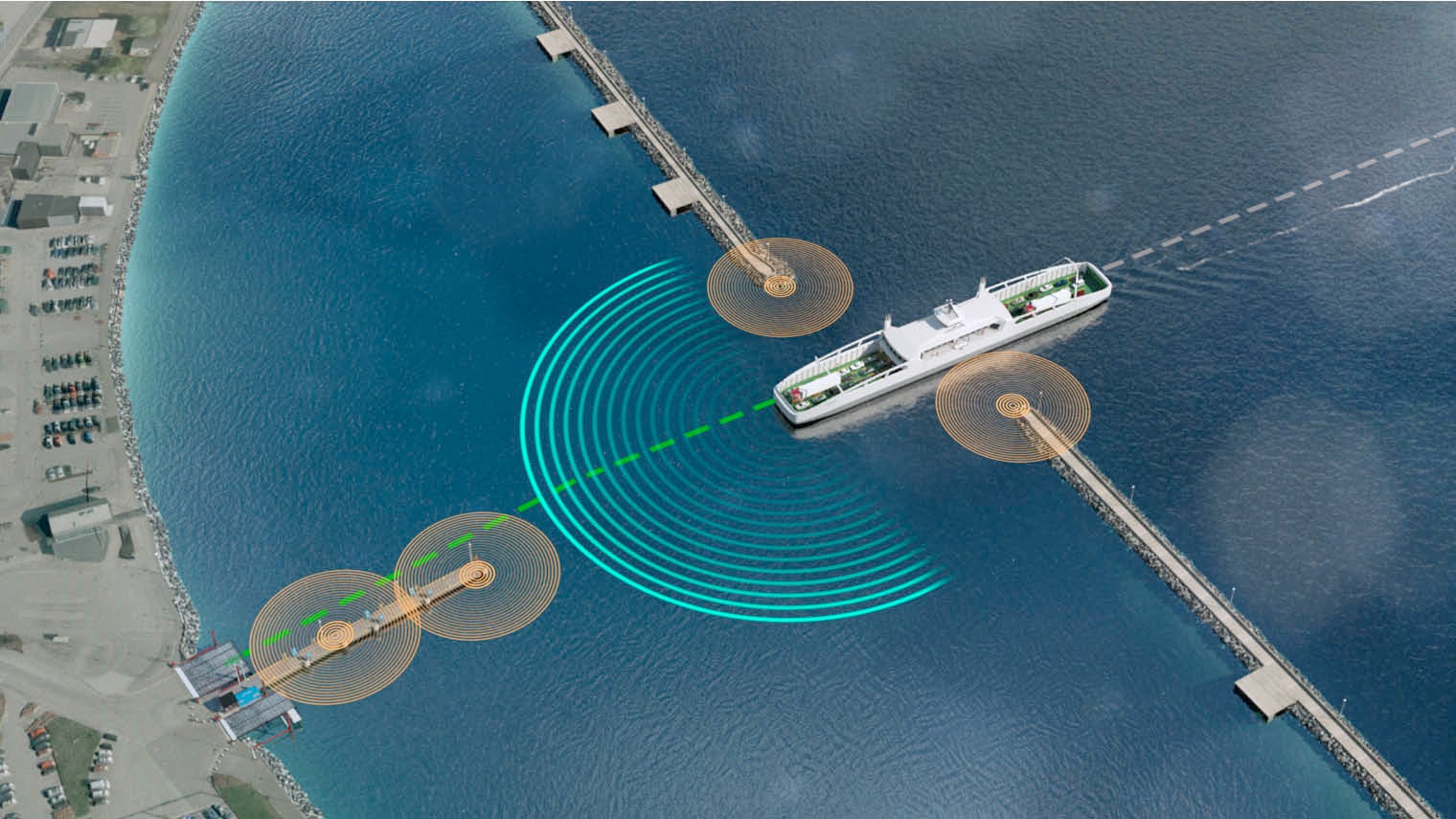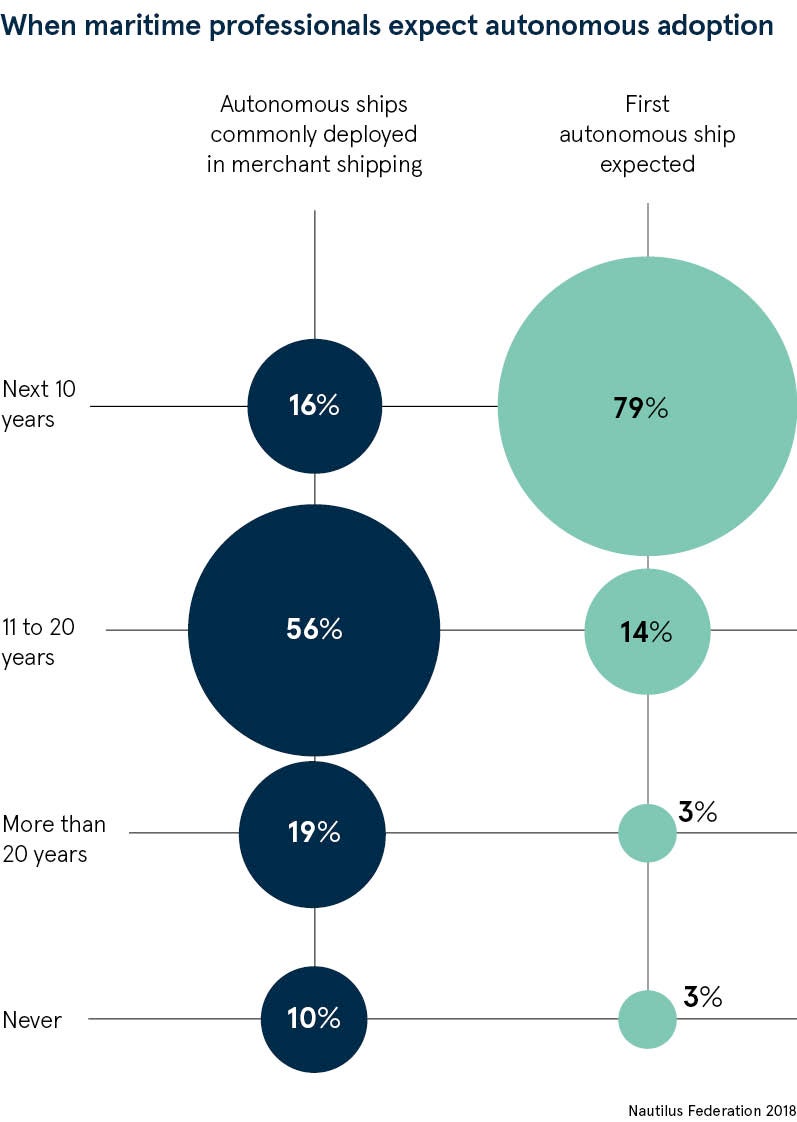According to Rolls-Royce Marine, by 2030 autonomous ships will be a common sight on the oceans. Last month the firm teamed up with Mitsui O.S.K. Lines (MOL) in a demonstration test on a ferry serving Japan’s Seto Inland Sea route equipped with its intelligence awareness system.
“Sunflower ferry operates in some of the most congested waters in the world and will provide an opportunity to test rigorously Rolls-Royce’s intelligent awareness system,” says MOL director Kenta Arai. “This can give our crews an enhanced decision support tool, increasing their safety and that of our vessels.”
This encapsulates the state of autonomous shipping at present, as there are paramount concerns about safety, and rigorous testing to ensure decision-making can be sufficiently robust to ensure conformity with the law and regulations of the sea.
Autonomous ships not quite on the horizon yet
However, Maersk chief executive Søren Skou has cast doubt on just how far and how fast matters will progress. Mr Skou does not see much advantage in taking the last few people off the vessel, even if commercial reasons and the technology suggested otherwise.
“I don’t expect we will be allowed to sail around with 400-metre-long container ships weighing 200,000 tonnes without any human beings on board,” he says. “I don’t think it will be a driver of efficiency, not in my time.”
In the short term, we are likely to see automated technologies and reduced crew on board for some manoeuvres, particularly short distances, and the desire to innovate will continue apace.
Iiro Lindborg, Rolls-Royce general manager of remote and autonomous operations, says: “The intelligence awareness system forms part of our ongoing development of autonomous ships, but we decided to make the technology available today as it offers real benefits to the existing shipping environment. It is undoubtedly one of the most significant advances made to date in terms of ship navigation safety. It provides bridge personnel with a much greater understanding of the ship’s surroundings.”

Rolls-Royce’s autodocking system automates the first and last phases of crossings, with various sensors that assess proximity to harbour structures
The pros and cons of autonomous shipping technology
Get it right and there are certainly benefits ahead for the industry. Isolated islands could be served, inhospitable routes navigated and remote areas accessed, much of it with diminished risk to seafarers.
As 80 per cent of accidents are human error, autonomous ships offer safer solutions than crewed ships. However, risk in shipping will remain; it’s just that the risk of human error is transferred onshore to a remote control centre. Also, with opportunity comes fear, as the industry worries about autonomous shipping leading to new forms of piracy.
Autonomous shipping projects began in 2015, with the advanced autonomous waterborne applications project, backed by the Finnish government, involving key players including Rolls-Royce and FinnFerries.
In the same year, a European Union-sponsored research project, maritime unmanned navigation through intelligence in networks, was completed. Other projects and research have ensued in Norway, the UK and China.
Last year, YARA and Kongsberg entered into a partnership to build the world’s first fully electric and autonomous container vessel, the YARA Birkeland. It is scheduled to switch to remote operation in 2019 and start performing fully autonomous operations from 2020 when it will sail between the ports of Porsgrunn, Brevik and Larvik.
Regulation around autonomous ships may give Scandinavia an edge
Scandanavia may be the place where regulation of autonomous shipping will emerge first, according to Professor Masamichi Hasebe, senior legal counsel at the Japan Association of Marine Safety. He says: “Denmark, Norway and Finland can change domestic regulation without waiting for international regulation. They can adopt by themselves. Also, like-minded countries such as Singapore and China may take the same approach.”
Existing international conventions, including Safety of Life at Sea, Convention on the International Rules for Preventing Collisions at Sea, Prevention of Pollution from Ships, and Standards of Training, Certification and Watchkeeping for Seafarers, were drafted on the assumption there is a crew on board.
Stephan Piazza, KPMG manager of shipping and yachting in Malta, says: “We want to get ahead of the game, but also we need to be sure certain provisions are self-adapting to future challenges.
“When it comes to ships and navigation, you must keep in mind that the lawmaker often ranks the protection of seafarers and the sea environment at the top of its priorities, ahead of such strictly navigational or commercial aspects, which also arise from the use of autonomous ships. It will be interesting to see how these two differing interests can and should coexist with each other.”
Laying foundations for the future
The International Maritime Organization (IMO) has agreed on a definition of maritime autonomous surface ships (MASS), as well as a framework for analysing the applicable IMO regulations. The IMO’s Maritime Safety Committee (MSC) has kicked off what will be years of regulatory and legal work by issuing a scoping exercise to determine the extent of the need to amend the regulatory framework to enable the safe, secure and environmental operation of MASS within the existing IMO instruments.
I don’t expect we will be allowed to sail around with 400-metre-long container ships weighing 200,000 tonnes without any human beings on board - Søren Skou, Chief executive Maersk
Speaking at an MSC meeting, IMO secretary general Kitack Lim said there needs to be a balance between new technologies, the efficiency of shipping, and “keeping in mind the role of the human element and the need to maintain safe navigation, further reducing the number of marine casualties and incidents”. The Comité Maritime International is also considering this issue through an international working group, analysing how international conventions and regulations can adapt themselves to autonomous ships.
Though Dr Piazza believes the IMO scoping should focus more on cybersecurity measures, as he explains: “The role of the IMO is that of creating uniformity, and uniformity is essential in shipping, so perhaps Scandinavia could become a model that is tried, tested and exported. Why not? Probably it is the best option. The IMO can move slowly for various reasons.”
Success of autonomous cars will determine future for shipping
Professor Hasebe says: “The IMO scoping exercise will go to the end of 2020, then actual practical drafting discussion will start and there is also a need to amend a number of conventions. Some could be straightforwardly amended, within two or three years, but more controversial ones could take longer, by which I mean the more political amendments addressing seafarers, for instance. We cannot expect to see all these changes within ten years.”
He believes shipping won’t take the lead because there is not yet enough interest in autonomous ships and navigation. However, he says: “If they can see the benefit on land, they will see the benefits of autonomous shipping. Solutions to autonomous driving on land can perhaps be achieved quicker, though they are more complex than sea, so if people can see the benefit of land solutions [with autonomous cars] then there will be a lot of pressure to achieve this on the sea.”
KPMG’s Dr Piazza concludes: “There’s a lot of work to be done and it will take 20 to 25 years, but it is good these tests have begun and discussions have moved forward: it is positive.” Law and regulation commonly lag behind, but there is an opportunity that with autonomous shipping, lawmakers may for once manage to keep pace with, if not get ahead of, innovation.
Autonomous ships not quite on the horizon yet


